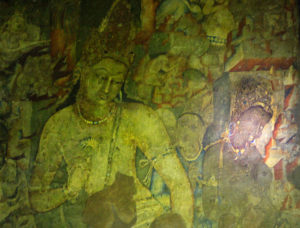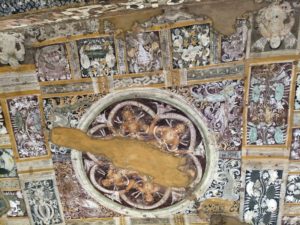
Kailasa Temple in Ellora Caves is an astonishing Shiva temple. It is 1,250 years old. The temple is a monolithic structure of basalt stone. Beautiful carved sculptures cram the temple. There are 32 caves in Ellora. In the sixteenth is Kailasa Temple. It portrays Kailasa or Kailash, the Himalayan sanctuary of Lord Shiva. Mount Kailash is regarded as the most sacred mountain in the world.
Mount Kailash is holy to Hindus, Buddhists, Jains and the Bon religion. People from India, Nepal, China, Japan and other countries go on pilgrimages to the mountain. This entails trekking towards Lake Mansarovar in Tibet and a circumambulation of Mount Kailash.
History of Kailasa Temple Ellora
There are no inscriptions in the temple to trace its history. But historians credit the construction to Rashtrakuta King Krishna I, during 756 to 773 CE. Later rulers further extended the temple. The master architect had chosen to excavate from the top of the mountain. Massive amounts of stone were dug out, without the help of modern machinery. Construction required the removal of 150,000 to 200,000 tons of solid rock. The temple stands independent of the surrounding rock. There are innumerable carvings on the inside and outside.
Ellora was never rediscovered, in contrast to other rock-cut sites in the Western Deccan such as Ajanta and Pitalkhora, . It has always been a holy place, known generally under the name of Verul. It drew pilgrims through the centuries down to the present day. Holy men occupied the cave temples over the years. It appears that even Aurangzeb paid a visit to the site on more than one occasion, probably from nearby Khuldabad.
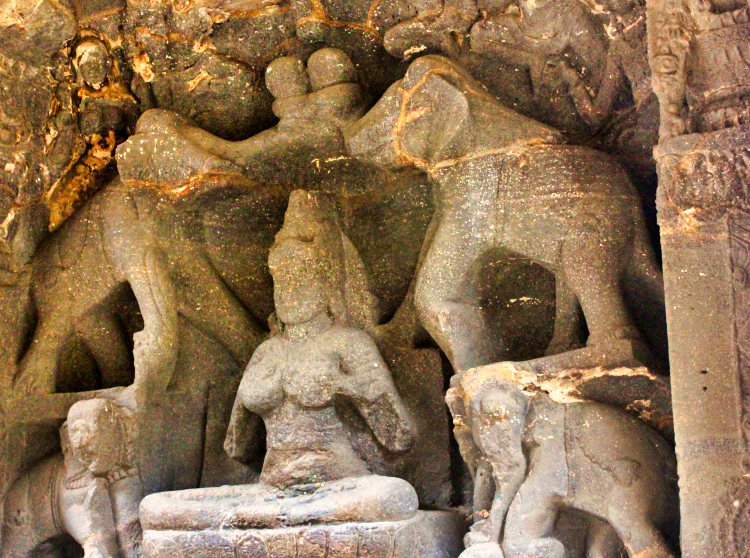
The picture shows elephants spraying water on Gajalakshmi. This magnificent panel is in front of the entrance gate. The goddess is sitting on a double lotus in kshirsagar (milk ocean). She is the goddess of fortune and wealth. The two small elephants are filling vessels with water. The elephants flanking her are shown pouring water from their trunk over the goddess. This aspect is representative of prosperity, good luck, and abundance. Gajalakshmi motifs are common in Hindu iconography.
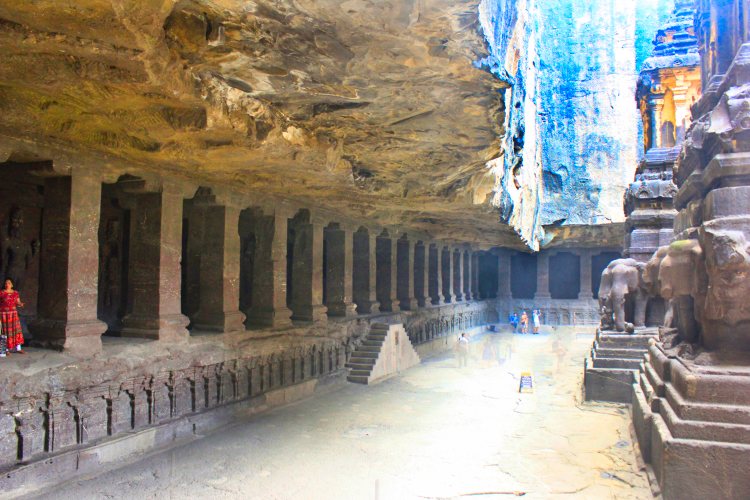
Shiva Sculptures
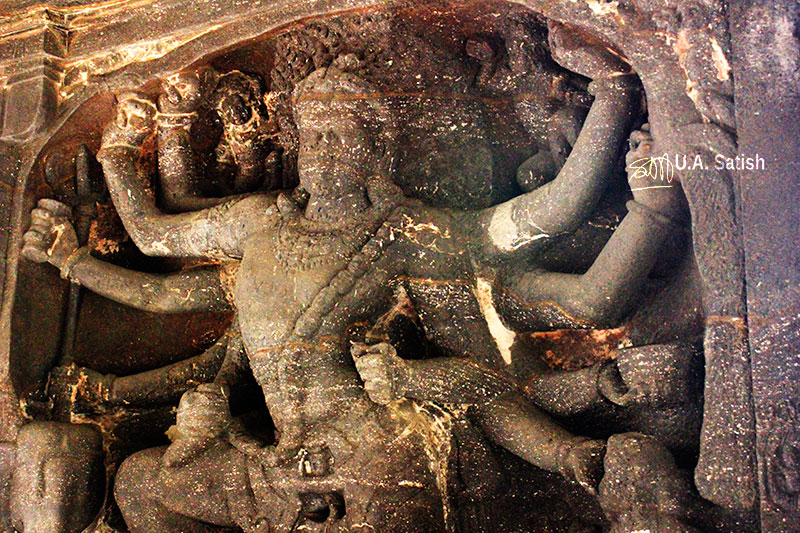
The sculpture of Shiva in Tandava dance is in the rare abhanga pose, balanced delicately by four hands on each side. He stands gracefully with weight of the body placed on one leg. The pose shows meditation, repose and serenity.
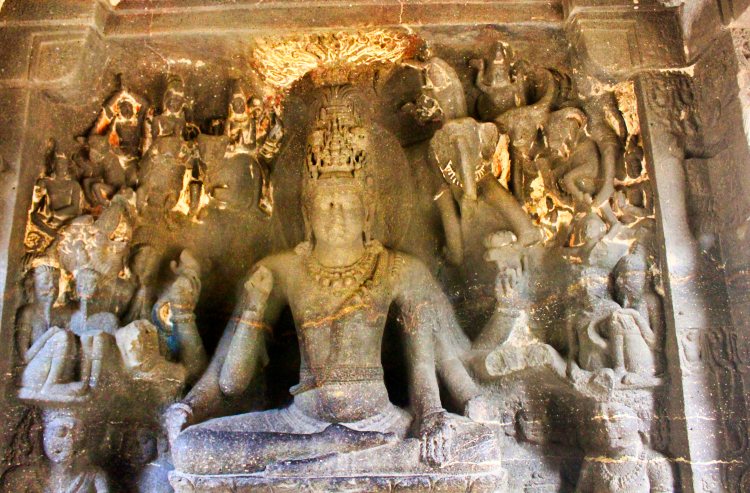
Yogeshwar Shiva is carved on a colossal panel in the hall. It shows an eight-armed Shiva seated in padmasana at the centre on a double-petalled lotus pedestal supported by lions. His haloed head is adorned with a high jatamukuta with a crescent moon. A tree above his jatamukuta touches top of the panel. On Shiva’s right side are Varuna on a crocodile, Vayu on a deer and Mahesha and Ishana on bulls. At the top of the panel on Shiva’s left are Indra on Airavata, Yama on his buffalo, Agni on a ram and Kubera on a dead man.
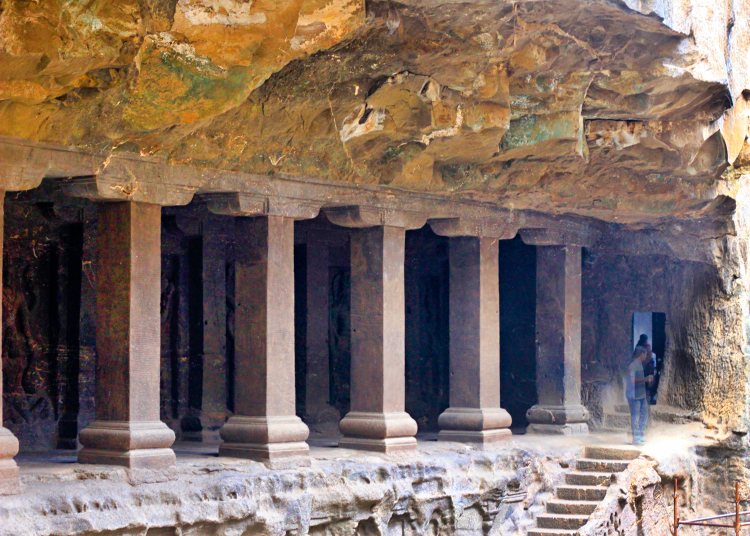
Construction of the Temple
The architecture of Kailasa Temple is notable for its vertical excavation. The work began at the top and moved downwards. Steel rod drills split the large boulders from the mountain. You can even now see the drill marks on the surrounding walls. Kailasa Temple is the only structure in the world that has been cut from the top down, a megalith carved out of a single rock, .
The main mandapa has sixteen pillars. In front of it is a mandapa for Nandi, the bull vahana of Shiva. On each side is a dwajastambam or flag pole. There are five detached shrines in the temple complex. On either side of the main temple on the exterior walls are two panels depicting scenes from Mahabharatha and Ramayana. The Ramayana panel in the southern wall portrays a number of events in seven rows.
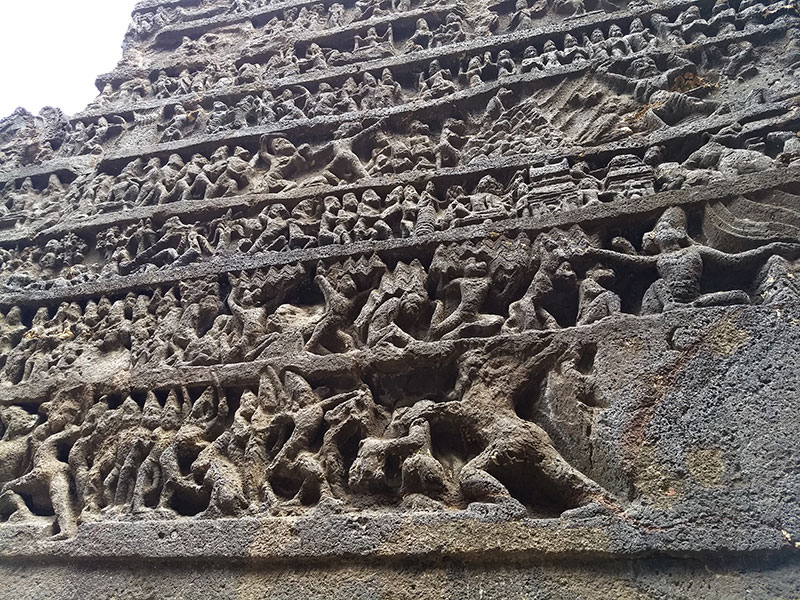
The northern wall has carvings showing scenes from Mahabharata. The panels are again in seven rows. The lower two rows display the childhood escapades of Krishna. The upper five rows have scenes of Arjuna’s penance, the Kirata-Arjuna fight and the Mahabharata war.
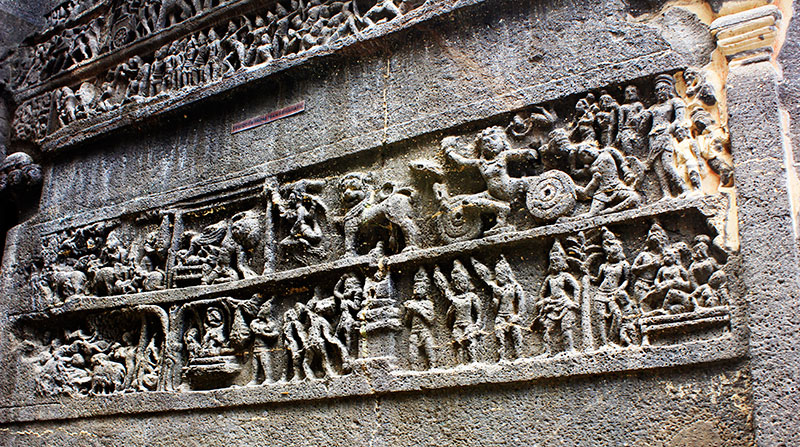
Architecture of Kailasa Temple Ellora
The temple architecture has Dravidian influences. The main temple has a U-shaped courtyard. A columned arcade three stories high surrounds the courtyard. The arcades contain enormous sculptures of deities and sculpted panels.
There are five subsidiary shrines around the main temple in the path that runs along the side of the hill. This includes a shrine dedicated to river goddesses Ganga, Yamuna and Saraswati and also a yajnashala (sacrificial chamber).
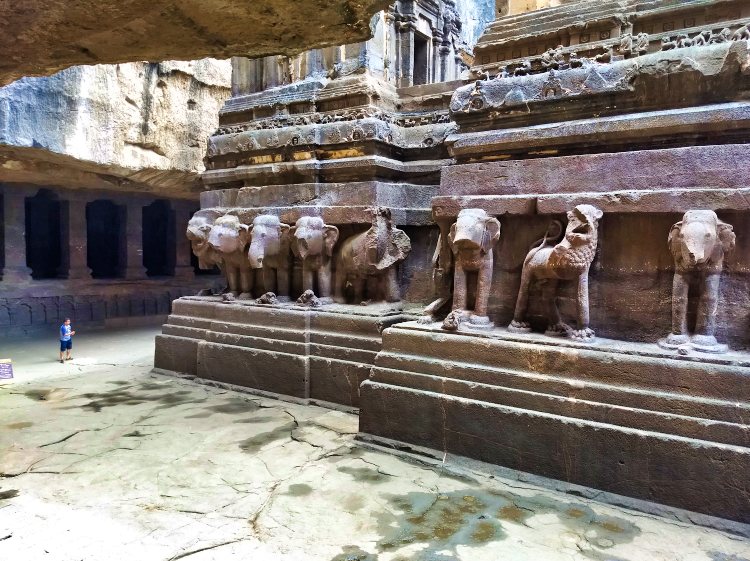
Elephants are auspicious animals in Hinduism. They are part of some religious ceremonies and functions in India. You will find life-size sculptures of elephants in Kailasa Temple.

There are two free-standing victory pillars (kirti stambhs) in the temple.
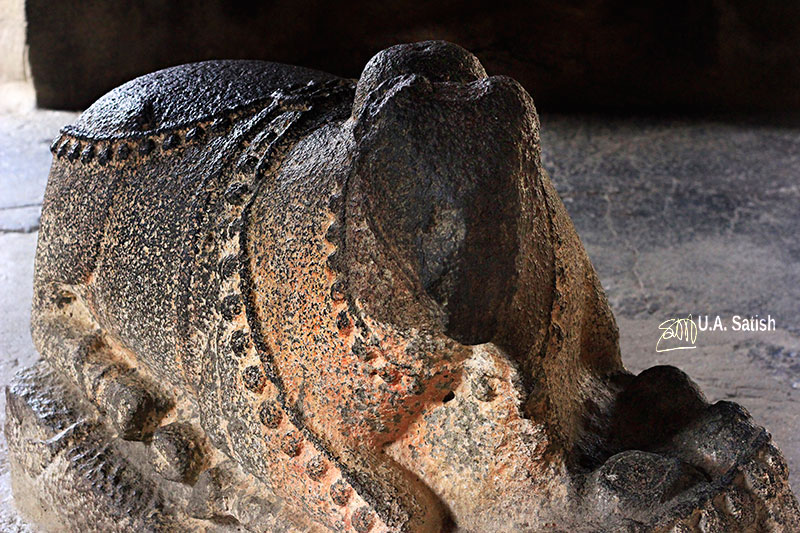
A sculpture of the sacred bull Nandi paying respects to Lord Shiva is in the centre of the temple. Most Shaivite temples have the sculpture of a humped bull resting on a raised platform and facing the shrine so that he may constantly gaze on Shiva.
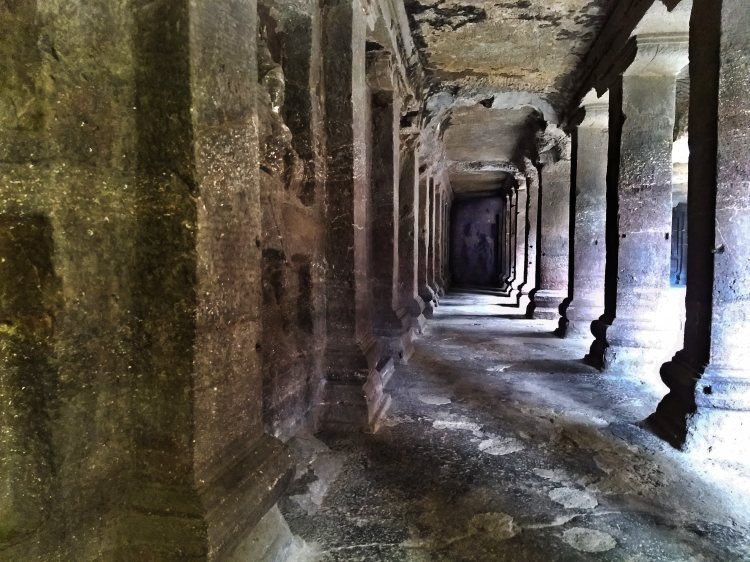
Mughal emperor Aurangzeb had tried to wreck Kailasa Temple. However he did not get much success. All he could inflict was minor damages but not to the main structure.
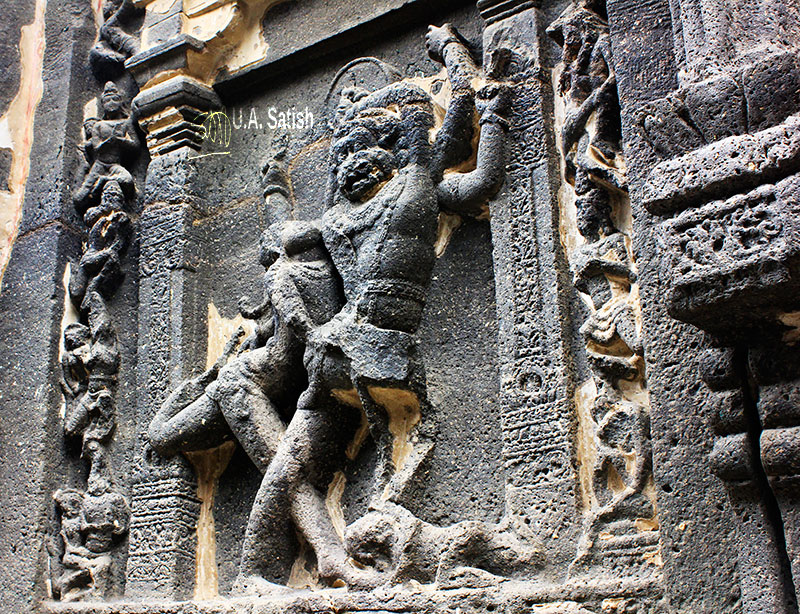
The sculpture shows Narasimha tearing out the guts of his enemy. Narasimha is one of the ten avatars of Lord Vishnu. He is in the form of a man-lion. The sculpture depicts Narasimha ripping open the belly of the demon Hiranyakashipu.
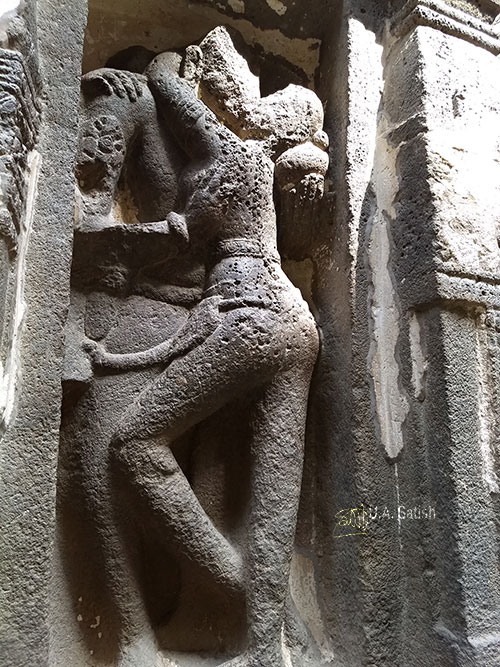
There are a few erotic sculptures on the outer walls of the temple.
If you liked the post, you could…
Join more than 5,000 fans of UASATISH by liking us on Facebook, or follow us on Twitter and Instagram.
You may also like to read:
